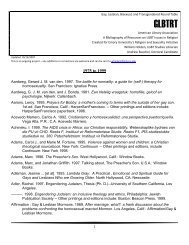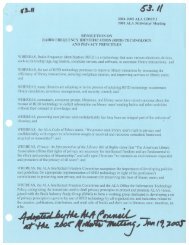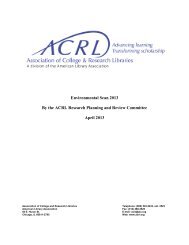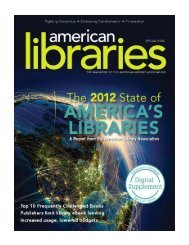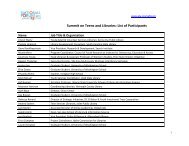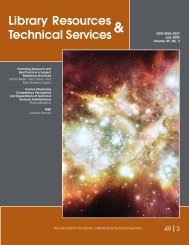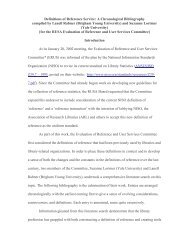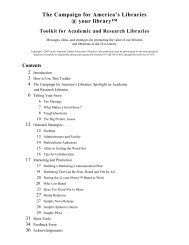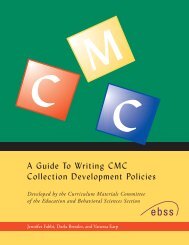Toolkit for School Library Media Programs - American Library ...
Toolkit for School Library Media Programs - American Library ...
Toolkit for School Library Media Programs - American Library ...
You also want an ePaper? Increase the reach of your titles
YUMPU automatically turns print PDFs into web optimized ePapers that Google loves.
Voices of Experience<br />
The following articles share insights and ideas from<br />
school library media specialists who have marketed their<br />
libraries successfully.<br />
Developing a Market Strategy<br />
By Terri Snethen and Joe Amos<br />
On the front page of the Metropolitan section of the July<br />
7, 2003, Kansas City (MO) Star was an article about<br />
school librarians fighting cuts in their programs. With<br />
many other districts facing the same struggles, it has<br />
become clear why school library programs and even<br />
individual school libraries must develop a marketing<br />
strategy.<br />
At Blue Valley North High <strong>School</strong> we operate a fourtiered<br />
marketing plan. The first tier consists of students<br />
and faculty. While it should be obvious why we market<br />
to the students, as they are the primary reason <strong>for</strong> our<br />
existence, we market just as hard to the faculty because<br />
we believe the faculty will be our “Pied Piper” to the<br />
students. Approximately 60 to 70 percent of our<br />
marketing is aimed at students and faculty and we try to<br />
market to each of those groups evenly.<br />
The second tier consists of the administration, both<br />
building and district including the school board. Because<br />
administrators are the ones making decisions about<br />
staffing and budget we must market our successes and<br />
ensure that they understand our vital roles as resource<br />
providers and curricular leaders. We aim 20 to 30<br />
percent of our marketing toward our administration.<br />
Our third layer is parents. Parents are valuable partners<br />
with the library whether helping to get overdue books<br />
returned or encouraging students to use the library’s<br />
resources at home. We direct about 5 to 10 percent of<br />
our marketing at parents.<br />
The final tier consists of community patrons. While<br />
community members may not to be able use our<br />
collections or only use them on-site, we need their<br />
support when bond elections come up, as well as in<br />
electing school board members who value library<br />
27<br />
programs and services. Admittedly, we aim less than 5<br />
percent of our marketing strategies directly at the<br />
community-at-large.<br />
Many of the strategies we use with students are quite<br />
simple, but since our main goal is to keep them aware of<br />
library services, we like simple strategies that are easy to<br />
implement and easy <strong>for</strong> the students to recognize. First,<br />
we have prominent locations <strong>for</strong> new books, fiction and<br />
nonfiction and advertise their arrival on our Web site. A<br />
monthly display advertises and encourages check out of<br />
books on a particular subject (Poetry Month, Women’s<br />
History Month, etc.).<br />
Our school has daily announcements that are read aloud<br />
and displayed on monitors throughout the school. We<br />
maintain a consistent presence in the announcements<br />
with book talks, book club in<strong>for</strong>mation and book<br />
reviews. We advertise not only newer popular titles but<br />
also less circulated titles that are great reads.<br />
This year we added peer tutoring to the library media<br />
center. Working with counselors and administrators,<br />
upper-class tutors were assigned to the library one hour<br />
each day. This type of program requires advertising to<br />
study hall teachers, so students in study halls can visit<br />
the library <strong>for</strong> help.<br />
We also have marketing and promotional activities<br />
aimed at the faculty. In our “Unfavorite Lesson Plan Day”<br />
we advertise that librarians are available all day to work<br />
with teachers on lesson plans or units they wish to<br />
improve. The librarians work with teachers to write<br />
improved lesson plans that may or may not include work<br />
in the library. It’s important that teachers trust that our<br />
goal is to support their ef<strong>for</strong>ts, not just promote our own<br />
program.<br />
We use e-mails to alert the faculty about articles in<br />
professional journals, new books, best practices, or even<br />
humorous stories and jokes about teaching. There are<br />
two characteristics required of these e-mails. The first is a<br />
clear subject heading so teachers know exactly what the<br />
e-mail is about. This gives the teachers the power to<br />
choose what they read. Second, we keep the messages<br />
as brief as possible. When sending out e-mails about



